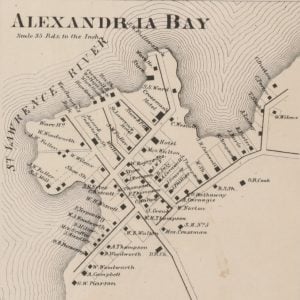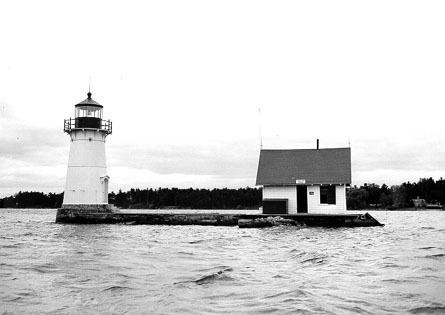
The site of this village was selected by Cadwallader Child, in 1804, while surveying a road from the Friends’ settlement to the St. Lawrence, as an eligible place for a port, and accordingly a reservation of a mile square was made by Mr. Le Ray for a village, which was surveyed out for that purpose by Edmund Tucker about 1818. Mr. Le Ray erected a tavern and warehouse, and for many years a thriving lumber trade was carried on, which continued as long as the supply lasted. This consisted of oak staves and square oak and pine timber. A considerable amount of valuable timber had been stolen from this town in common with the whole front of the State on the St. Lawrence, before there was any one to assert the title of the proprietors. The lower wharf at this place was built by Fuller and Walton in 1832, and the upper one by Walton and Hamblin in 1840. The port has always been a landing-place for the American steamers, and is an important wooding station. In the last two years (1852-53) about 12,000 cords have been sold each year. A custom-house was established at this port in 1828, subordinate to the Cape Vincent district, while John B. Esselstyn was in charge of that office. The deputies here have been Hiram Davis, Azariah Walton, John W. Fuller, A. Walton, Edwin Tanner, Martin J. Hutchins, and Ebenezer Campbell, the present incumbent. Mr. Walton held the office for eighteen and a half years, and Mr. Campbell for fourteen years. Among the earliest settlers of the village were Jerre Carrier, John W. Fuller, David Hunter (within half a mile of the village), Samuel Bingham, all prior to 1820; Ira Beckwith, Tillotson, Henry Westcott, Chauncey Westcott, before 1825; Azariah Walton, 1828. The place improved somewhat slowly, there being nothing but the lumber trade to sustain it. That, however, gave the embryo village the appearance of an active and busy settlement, which continued for many years.
The first tavern was erected by Mr. Le Ray, as before stated, in 1818. The old building still remains a landmark of the past, having acquired a venerable antiquity. It is now owned by Chauncey Westcott, — himself the pioneer settler of the place,— and is by him used as a carpenter-shop and store-house.
The first log house was erected by John W. Fuller, in 1818, and the first frame house by Dr. Jerre Carrier, in 1820. The latter occupied the present site of the St. Lawrence Hotel, of which, in fact, it forms a part.
The first store was erected by Messrs. Jerre Carrier and John W. Fuller, and stood on the Point, occupying the present site of the Centennial Ice-Cream Saloon.
The first school was a primitive log structure, erected in 1821. It stood on the lot now occupied by the Reformed church.
The first church edifice was that of the Reformed Protestant Dutch church society, erected in 1848, and opened for public religious worship in 1851.
As a Summer Resort
For more than a quarter of a century Alexandria Bay has been visited as a summer resort. Its location in the immediate vicinity of the most numerous cluster of the Thousand Isles, and its beautiful situation on the St. Lawrence, constitute the salient characteristics of its popularity. In 1848, Mr. C. Crossmon commenced keeping hotel at the Bay, and has been continuously and successfully engaged in that business ever since. But it was not until 1872 that the rush to the Bay commenced, although a few persons, some of them men of note, had made it their summer vacation place for years. Among these early visitors were Governor Seward, Martin and John Van Buren, Silas Wright, Frank Blair, Preston King, General Dick Taylor, and Rev. George Bethune. In 1872, President Grant and family, and a party of their friends, accepted an invitation from George W. Pullman, of palace-car notoriety, to visit his island cottage. Some splendid entertainments were given, and the people flocked to the Bay by thousands. This and the event of the sojourn there of the State Editorial Association, at which time Messrs. Crossmon & Son prepared an outdoor repast for three hundred guests, which was pronounced by those present (and editors are generally fair judges of things gastronomic) to have been a capital feast in every particular, brought the place favorably before the public. In 1872-73 the present magnificent “Thousand-Island House” and the equally fine “Crossmon House” were erected and thrown open to the public with becoming éclat. Since this time the popularity of the Bay has become a fixed fact, and no watering-place receives a better or more elegant patronage. While everybody concerned have done all in their power to enhance the beauties nature has so lavishly bestowed upon this most lovely spot and its equally glorious surroundings, to Mr. Charles Crossmon is undoubtedly due, in a large measure, the brilliant success that has attended the establishment of a watering-place there. The islands in the vicinity of the Bay are being rapidly utilized for cottages, and about seventy-five of these charming and cozy temporary habitations have already been erected. Of these islands Wells, also known as Wellesley Island, a part of which lies opposite the Bay, is the most important. It contains upwards of eight thousand acres, is eight miles long and from three to four in width, and is inhabited by a thrifty class of citizens. Here, too, are located the International Camp Ground and Westminster Park, the former nominally under the auspices of the Methodist Episcopal church, the latter under the control of the Presbyterian body. Hart’s Island, opposite, and near Alexandria Bay, is the spot where, it is claimed, Thomas Moore wrote his “Canadian Boat Song,” which has been sung for half a century in American and Canadian homes.
In a recent publication issued in the interest of the Crossmon House, the sports and pleasures of the place are thus enumerated: “Boating, fishing, hunting, cruising among the islands in row-boats or steam-yachts, visiting the many points of historical or traditional interest, picnicking in large or small parties, open-air feasting and lounging under the trees near the water’s edge, are terms which sum up the principal sports of the river.”
Of piscatorial sports the writer discourses as follows: “Black bass and pickerel, large and gamy, abound in these waters. Many muscallonge are also caught every season, and the lady or gentleman who hooks and secures one of these best of all fresh-water fish becomes the heroine or hero of the day. Occasionally a muscallonge weighs as high as forty pounds, a pickerel as high as twenty pounds, and a bass as high as six or seven pounds.”
The village contained, according to the census of Mr. Rottiers, compiled in 1850, 27 dwellings, 30 families, and 164 inhabitants. It now has a population fairly estimated at 500. It contains 3 general stores, of which Carnell Bros., Sisson & Fox, and William J. Woodworth are the proprietors respectively; 1 grocery-store, kept by J. P. Thomson; 1 millinery-store, harness-shop, 2 blacksmithies, 1 wagon-shop, steam saw- and plaster-mill, 2 magnificent hotels, — the “Thousand Island House,” kept by O. G. Staples, and the “Crossmon House,” by Crossmon & Son, — 2 churches, — one each of the Reformed and Methodist Episcopal denominations, — a good public school, post-office, and telegraph-office, a line of steamers, plying between Clayton, the terminus of the Utica and Black River R. R. and the bay, tri-daily during the season, several boat-houses, pleasure steam-yachts, ice-cream parlors, photograph establishments, and the numerous other essentials to a fashionable and deservedly popular summer resort.
Sunken Rock lighthouse, in front of this port, was erected in 1846, but was not used until the following year.
Source: Durant, Samuel W. and Henry B. Peirce. History of Jefferson County, New York, With Illustrations and Biographical Sketches of Some of its Prominent Men and Pioneers. Philadelphia: L.H. Everts & Co., 1878. p 268-269.
